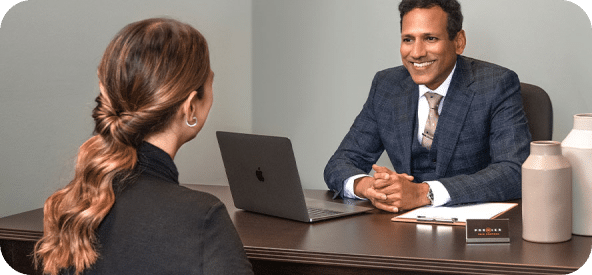Radiofrequency Ablation (RFA)
How is Vein RFA Performed?
Preparation:
To prepare for the RFA procedure, wear comfortable and loose-fitting clothes. The procedure will occur in our office, where the doctor will explain the process and answer your questions. They will request that you lie down comfortably, and the doctor will inject a local anesthetic before proceeding.
Anesthetic:
Using ultrasound guidance, the doctor inserts a small catheter through an incision in the vein and passes an electrical current directly to the affected vein.
Recuperation:
After the vein RFA procedure, it takes about 30 minutes to complete. You can resume your daily routine immediately, but it is advised not to drive or engage in strenuous activities.


Post-Procedure Expectations
After the session, you can resume your normal activities and walk, but you should refrain from diving or engaging in strenuous activities for a while. You may experience some pain and a tightening sensation a few days following the procedure, which is typical. The doctor will instruct you to wear compression stockings and avoid exposing the treated area to water to prevent swelling and promote healing.
Frequently Asked Questions
RFA is considered one of the safest and most advanced treatments for veins. However, it may still result in some minimal risks and side effects, such as:
- Skin burns
- Pain
- Feelings of burning
- Prickling
- Blood clots
- Nerve damage
The doctor will administer a local anesthetic, so you should not feel pain. However, you may feel some pressure during the procedure.
Yes. Radiofrequency Ablation is a minimally invasive outpatient procedure for veins that employs a local anesthetic so that you will remain awake throughout the treatment.
After the procedure, the doctor will bandage the treated area. You should avoid using saunas or hot tubs for the next few weeks to prevent getting them wet. Refrain from engaging in any strenuous activities. It’s important to discuss any additional aftercare instructions with your doctor.
Radiofrequency Ablation is considered one of the top treatments for varicose and spider veins due to the following reasons:
- It’s remarkably safe, with minimal risks of complications, especially in comparison to other treatments.
- It has a success rate of over 90%.
- It is an outpatient procedure and does not require hospitalization.
- The procedure typically takes less than an hour to complete.
- Recovery time is usually brief.
However, since each patient’s situation is unique, discussing your particular vein treatment plan with your doctor is always advisable.
Depending on your specific situation, your doctor may suggest the following treatments:
- Laser treatment: This method uses laser energy to heat the veins, like radiofrequency ablation.
- Sclerotherapy: This treatment involves injecting a solution into the affected veins, causing them to shrink.
- Vein stripping or vein surgery: This procedure involves physically removing the problematic sections of the vein.
It’s crucial to consult your doctor to determine which treatment option is most suitable for your particular case.

How may we assist you?
Request a Consultation
We are here to assist you in getting the care you need. Please provide us with your contact information, and we will help you schedule an appointment, verify your insurance coverage, or answer any questions. Our top priorities are your health and well-being.
Tell us how we can reach you.
Find Your Nearest Clinic
Locate one of our clinics near you and prioritize your health today. Our top-rated medical centers offer multiple services and convenient locations to provide patients with needed care. Contact us today to schedule an appointment!
Find Your Nearest Clinic
Locate one of our clinics near you and prioritize your health today. Our top-rated medical centers offer multiple services and convenient locations to provide patients with needed care. Contact us today to schedule an appointment!
Find Your Nearest Vein Clinic
With 9 convenient locations, our top-rated clinics are easily accessible to provide you with the best care. Trust us to prioritize your health and well-being, and experience the ease of having a clinic near you.
